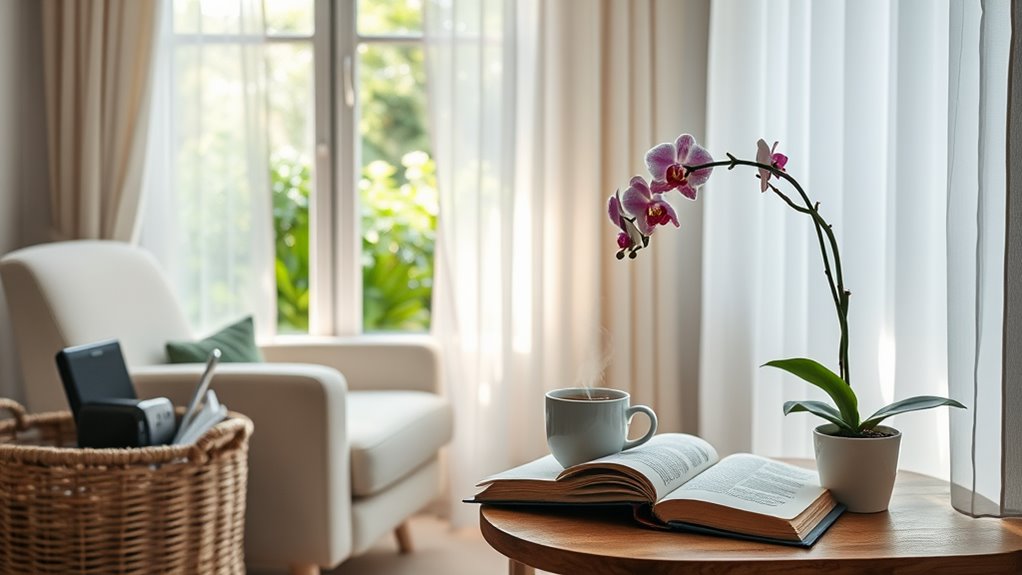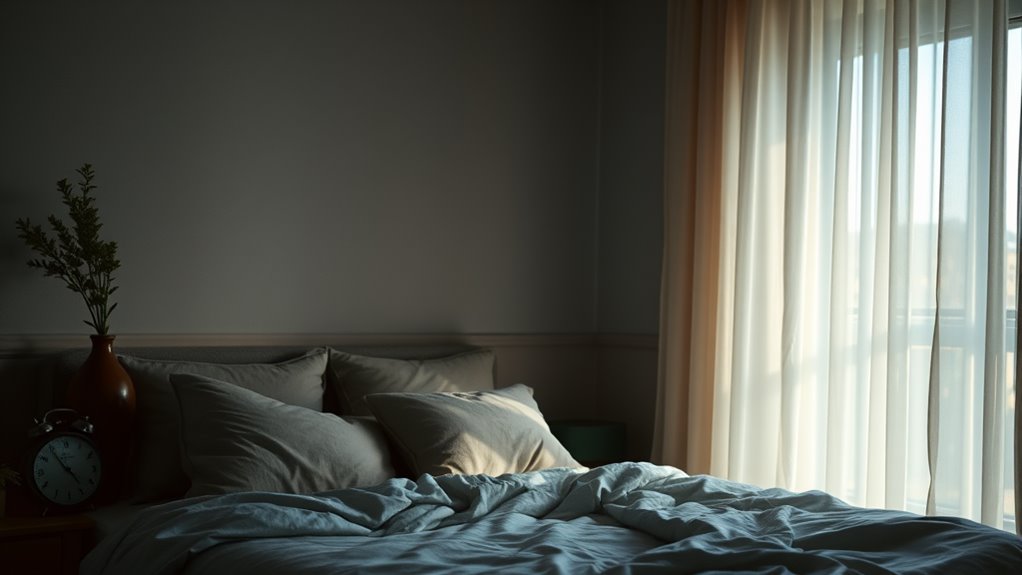
You’re constantly connected, and it’s time to reclaim your mental peace with a digital detox. Start by setting clear screen time boundaries; reducing screen exposure can improve concentration. Limit social media usage to a few meaningful platforms and disable notifications to minimize distractions. Create tech-free zones in your home for enhanced real-life connections, and embrace device-free periods to encourage mindfulness. Immerse yourself in offline activities like gardening or art to lower stress and lift your mood. Enhance sleep quality by removing devices from your bedroom, and enjoy deeper rest. There are more ways to transform your digital detox into a nourishing routine.
Setting Screen Time Boundaries
In today’s fast-paced digital world, setting clear screen time boundaries is essential. You’re traversing a landscape buzzing with distractions, making screen time awareness a powerful tool. Reflecting on your digital habits, you might notice patterns of excessive use—compulsive social media checks and late-night streaming sessions disrupt your peace. Recognizing these habits not only brings awareness but opens the path to adjustment.
Consider the toll your screen time could be taking on your mental well-being. Excessive use can manifest as anxiety, trouble being present, or even an obsession with digital validation through likes and comments. Reflecting on these feelings allows you to dissect the content you consume, evaluating its impact on your self-perception and emotional health. Awareness is liberating; it’s the first step toward meaningful change. With a focus on digital eye strain, you might also find that reducing screen exposure helps alleviate discomfort and improves your ability to concentrate.
To take control, begin establishing practical boundaries. Identify areas that cry out for adjustment—social media use, email compulsions—and limit these distractions.
Switching off devices before bed enhances sleep quality in increments. Using phone features to set daily limits cultivates discipline, while disabling social media and news notifications reduces constant interruptions.
Embrace this journey toward a freer, more balanced digital experience.
Scheduling Device-Free Periods
Envision this: amid the relentless, incoming tide of notifications and alerts, you purposefully carve out uninterrupted, device-free zones in your day. Research has shown that excessive screen time can hinder face-to-face interactions, so prioritizing these intervals is crucial. Imagine liberating yourself from digital communication by informing friends, family, and colleagues about your digital detox plans. Set an automated email response to manage expectations—it’s a pivotal step in respecting your device-free time while ensuring they know how to reach you, should the need arise due to an emergency.
Plan these intervals when you’re less likely to encounter disruptions; perhaps your calendar points to a quieter period. Check your schedules to align these moments with less demanding project phases or minimal client commitments. Synchronize these moments with enriching activities like exercise, yoga, meditation, or face-to-face gatherings. Incorporating mindfulness practices into your routine can elevate mood and decrease stress during these device-free periods. Each day, gradually increase your digital-free time—one hour on the first day, two on the next.
Soon, you’ll anticipate these breaks as a sanctuary of mindfulness and genuine connection. Weekends or days off are perfect for extended device-free stretches, culminating in a full day of pure offline living as your detox unfolds.
Creating Tech-Free Zones

Having established a routine of device-free time, you can further enhance your digital detox journey by creating tech-free zones.
These spaces, intentionally designed to free you from digital shackles, will offer moments of genuine connection and relaxation. Get your family involved right from the start in designating tech-free areas in your home. The bedroom, dining room, or family room can become havens where digital distractions can’t reach.
Here’s a simple guide to setting up your tech-free sanctuary:
- Comfortable Seating: Transform these zones with plush couches or bean bags that invite you to unwind.
- Natural Elements: Integrate plants and soft lighting to bring serenity and a touch of nature into your space. Not only do these natural elements provide a calming atmosphere, but they also help reduce stress levels, contributing to improved overall well-being. Engaging with nature in these spaces can also enhance your mindfulness and meditation, promoting mental clarity and reduced stress.
- Sensory Features: Introduce calming music or aromatherapy for enhanced sensory relaxation.
- Clear Markings: Make these zones unmistakably tech-free with signs, ensuring everyone knows the rules.
Enjoying Offline Activities
Reconnecting with the world offline can be both liberating and fulfilling. You’ve got a whole universe of activities waiting for you, beyond the constant hum of digital devices.
Immerse yourself in nature exploration by going for a hike in the mountains, visiting a botanical garden, or simply taking a walk in a local park. These experiences allow you to immerse yourself in the richness of the natural world, far from screens and notifications. Outdoor exercise is linked to higher self-esteem compared to indoor workouts, providing mental and physical health benefits.
Community bonding is another rewarding way to enjoy offline life. Consider joining a local club that piques your interest—a book club, gardening group, or even a knitting circle can be a perfect fit. Not only will you learn something new, but you’ll also build connections with like-minded individuals. Stepping away from digital devices reduces stress and anxiety, making real-world interactions more enjoyable and fulfilling. Host a potluck dinner, invite friends over, or spend time volunteering. Such interactions strengthen relationships and foster a sense of belonging, reminding you of the joys of genuine, face-to-face communication.
Practicing Mindfulness and Presence

A quiet room, a few deep breaths, and the gentle focus of the mind can lead you into the heart of mindfulness and presence. Embracing these practices allows you to connect deeply with yourself, silencing the digital noise and reclaiming the serenity within. Start with *mindful breathing* to center yourself. Feel each breath journey through your body, grounding you in the present moment. Excessive digital use has been linked to increased stress and anxiety levels, emphasizing the importance of mindfulness in mitigating these effects. Engage all your senses to heighten awareness—notice how the air gently flows in and out, calming the chaos of daily life.
Infuse your day with nature appreciation, whether it’s a walk in the park or savoring the beauty of a garden. Let natural settings inspire mindfulness, inviting a sense of wonder and liberation. Incorporating sensory awareness techniques like the 5-4-3-2-1 method during your walks can also promote calmness and grounding, further enhancing your mindfulness practice in nature.
Here are some ways to incorporate mindfulness into your digital detox:
- Mindful Walking: Stroll slowly, noticing each step and surrounding sounds.
- Guided Imagery: Visualize calming scenes to declutter your mind.
- Meditation Practices: Explore sitting or walking meditations to nurture awareness.
- Mindful Movement: Practice yoga or gentle stretches to release tension.
These practices can cultivate presence and reduce stress, empowering you to redefine your relationship with digital devices.
Utilizing Digital Wellbeing Tools
Utilizing digital wellbeing tools offers you a practical pathway to regain control over your digital habits. With focus tools like Freedom, you can block distracting websites and apps across multiple devices, ensuring your attention remains undivided. Engage its lockdown mode to prevent any alterations to your blocked list, reinforcing your commitment to a distraction-free environment. Mindfulness meditation can also reduce overthinking and improve your focus. As you create space for mental clarity, incorporate ambient music and sounds to enhance your focus, allowing productivity to flow naturally. Incorporating digital tools can offer accessibility to mental health resources from home, making it easier to maintain wellness in your daily life.
Digital journaling, another powerful ally in your liberation journey, helps organize thoughts and tasks through platforms like Alan Mind (Jour). This tool merges daily planning with journaling, helping you create a routine that doesn’t feel confining but rather empowering. Crafting to-do lists with this app can structure your day, reducing anxiety and offering a clear roadmap for what truly matters. Interactive activities further enrich your routine, enabling you to manage stress through thoughtful goal setting.
Together, focus tools and digital journaling foster an environment where digital addiction shrinks, and mindful engagement thrives, paving your way towards a balanced and intentional digital life. Embrace this path to unshackle from digital chaos, inviting calm and focus into each day.
Limiting Social Media Usage

With over 5.22 billion social media users worldwide, it’s no surprise that limiting social media usage has become essential for many seeking a balanced lifestyle.
Social media mindfulness isn’t just a trend; it’s a necessity for reclaiming your freedom from the digital world. By practicing balanced engagement, you can enjoy the perks of social media without letting it dominate your life or your time.
Consider these practical tips:
- Set Time Limits: Allocate specific times for social media and stick to them. Tools and apps can help regulate usage, keeping daily screen time under control.
- Be Selective with Platforms: Engaging with an average of 6.8 platforms monthly? Narrow it down to the few that genuinely add value to your life.
- Unfollow or Mute: Curate your feeds by unfollowing accounts that don’t resonate with your values or interests. You’ll find the content is more enjoyable and less overwhelming.
- Create No-Tech Zones: Designate areas in your home or times in your day when social media is off-limits. This fosters social media mindfulness and enhances real-life connections.
Embrace these steps to liberate yourself and enjoy the benefits of digital balance.
Engaging in Creative Hobbies
Diving into creative hobbies is a powerful way to enhance your mental well-being and escape the stress of daily life. Embracing art therapy or creative journaling can provide a much-needed break from the constant digital noise. These activities bring you into the “flow” state where time seems to dissolve, promoting relaxation and reducing cortisol levels, the notorious stress hormone.
Engaging in creative tasks isn’t just about creating something beautiful; it’s a form of self-care that can lift your mood and improve mental health. Whether it’s painting, playing music, or just jotting down thoughts in a journal, these hobbies help you express emotions constructively, lowering anxiety and depressive symptoms.
You’ll find that even a brief garden session can calm your mind and fill you with a renewed zest for life. Immersing yourself in creative hobbies also stimulates cognitive functions, enhancing brain activity and confidence.
These activities don’t just boost your mood—they sharpen your analytical skills and contribute to overall happiness and life satisfaction. Ditch the screens, pick up that paintbrush or pen, and reconnect with what truly matters. You’re embracing a journey toward liberation and well-being.
Enhancing Sleep Quality

Transform your bedtime routine into a haven for restful slumber by focusing on enhancing sleep quality. To achieve a liberating night’s sleep, consider reshaping your sleep environment and embracing empowering bedtime rituals.
The digital world’s allure often eats into your relaxation time, so it’s essential to make intentional changes. Start by minimizing your exposure to blue light to align with your natural circadian rhythm and promote melatonin production.
Here are some transformative strategies:
- Eliminate digital distractions: Remove devices from your bedroom to create a serene sleep environment. This reduces interruptions and paves the way for uninterrupted rest.
- Curtail blue light exposure: Avoid screens for three hours before bed. Consider enabling night mode or using blue light filters to protect your natural sleep cycle.
- Develop a calming bedtime ritual: Engage in non-digital activities like reading or meditating to signal your mind and body it’s time to wind down. A consistent routine can improve both the onset and quality of your sleep.
- Use traditional tools: Switch to a simple alarm clock instead of your phone. This prevents the temptation to scroll or react to notifications, promoting peace as you retire for the night.
Incorporating these strategies liberates you from the constraints of digital disturbance and empowers deeper, revitalizing slumber.
Unplug for Deeper Rest
Unplugging from digital devices isn’t merely a trend but a necessary practice for cultivating a more balanced and healthier lifestyle. The unceasing connection to our screens has contributed to heightened levels of stress and anxiety, making a digital detox more important than ever for mental well-being.
By deliberately limiting exposure to digital stimuli—especially during meals and before bedtime—individuals can find solace and lower stress levels. Setting boundaries for digital consumption not only helps manage stress but also enhances focus and productivity. When people consciously decide to check their emails and social media at specific times, they avoid the pitfall of distraction, allowing for more efficient completion of tasks.
Such deliberate withdrawal from screens empowers individuals to reclaim their attention, fostering an environment where concentration thrives. Digital detox does more than just clear one’s mind; it rejuvenates relationships and personal connections. In our world saturated with digital communication, the art of face-to-face interaction often diminishes.
By prioritizing offline engagements and encouraging physical presence, relationships can blossom into more meaningful bonds. Sharing digital detox plans with loved ones not only sets expectations but also garners support from a community that values real-life connections.
Additionally, unplugging from devices provides individuals with the opportunity to rediscover activities they enjoy. By scheduling specific tech-free days and creating technology-free zones, people are encouraged to reignite passions for hobbies such as reading, exercising, or gardening, cultivating a more fulfilling life.
The benefits of a digital detox are far-reaching, laying the foundation for long-term lifestyle changes that prioritize mental health, productivity, and interpersonal relationships. As individuals take steps towards unplugging, they ultimately create a balanced life enriched with meaningful moments and deeper rest.













